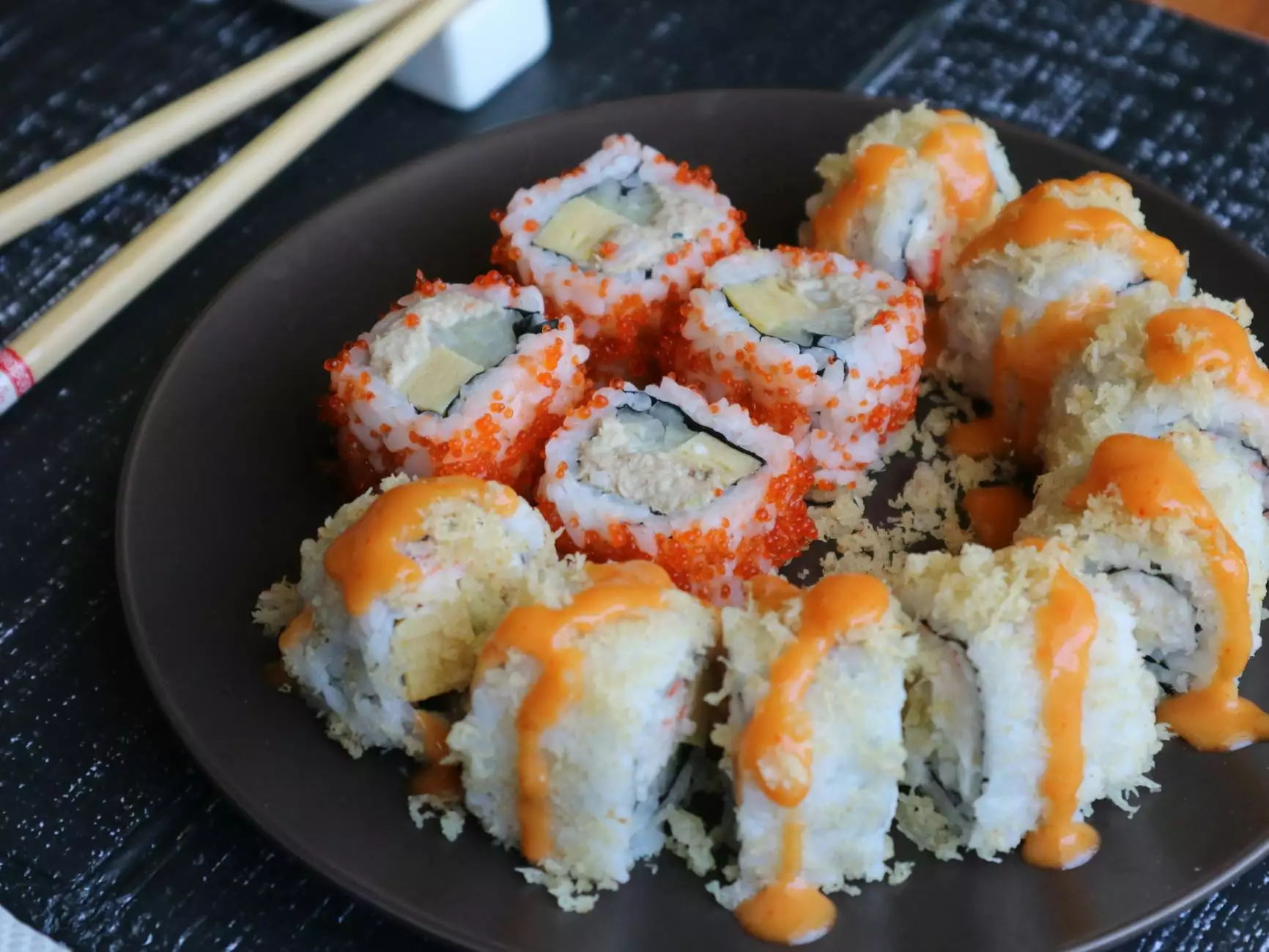Discovering the Essence of Japanese Wasabi

Japanese wasabi is not just a condiment but a culinary experience that has captivated the taste buds of diners around the world. Known for its distinct flavor and pungent aroma, wasabi plays a crucial role in Japanese cuisine, particularly in enhancing the taste of sushi, sashimi, and other delicacies. This article delves deep into the world of Japanese wasabi, exploring its origins, culinary uses, and importance in restaurants and sushi bars.
The Origins of Japanese Wasabi
Native to the stream beds of Japan, specifically in regions like Nagano and Shizuoka, wasabi is a plant that has been cherished for centuries. Unlike the popular horseradish found in many Western cuisines, authentic wasabi (wasabi japonica) has a unique flavor profile that is both spicy and aromatic. It is traditionally cultivated in the cool, flowing waters of mountain streams, which provide the perfect environment for the plant to thrive.
Why Japanese Wasabi is So Unique
The uniqueness of Japanese wasabi can be attributed to several factors:
- Flavor Profile: Authentic Japanese wasabi offers a sharp, intense heat that dissipates quickly, leaving a fresh, herbal aftertaste. This subtlety contrasts sharply with the lingering burn of horseradish.
- Freshness: Real wasabi is best served fresh. When grated, it releases essential oils that contribute to its flavor, making fresh wasabi much more desirable than its prepared counterparts.
- Cultural Significance: In Japanese culture, wasabi is often considered a symbol of purity. Its use in traditional meals represents an appreciation of the simplicity and richness of natural flavors.
How to Identify Genuine Japanese Wasabi
Due to its high demand and popularity, many imitations of wasabi exist on the market, often made from horseradish and colored with green dye. To ensure you are experiencing authentic Japanese wasabi, look for the following signs:
- Appearance: Genuine wasabi is a pale green color and has a smooth, moist texture. Fake versions often appear unnaturally vibrant.
- Grating Method: Authentic wasabi should only be grated with a fine, traditional tool called a oroshigane to release its full flavor.
- Taste Test: When you taste real wasabi, you will experience an intense yet fleeting heat that quickly gives way to a fresh, fragrant taste. If the heat lingers for too long, it may be an imitation.
Culinary Applications of Japanese Wasabi
In Japanese cuisine, wasabi is often paired with a variety of dishes. Its versatile nature elevates flavors and provides a unique dining experience. Here are some ways Japanese wasabi is used in restaurants and sushi bars:
Sushi and Sashimi
One of the most popular uses of wasabi is as a condiment for sushi and sashimi. Its spicy kick complements the delicate flavors of fresh fish, enhancing the overall experience. In high-end sushi bars, chefs will often place a small amount of freshly grated wasabi directly on top of the fish, allowing diners to experience the authentic flavors firsthand.
Marinades and Dressings
Wasabi can also be incorporated into various marinades and dressings, adding a distinctive flavor to salads, grilled meats, and seafood dishes. Chefs often blend it with soy sauce for a zesty dipping sauce, perfect for tempura or grilled vegetables.
Innovative Dishes
As cuisine continues to evolve, innovative chefs are exploring the potential of wasabi in non-traditional dishes. From wasabi-infused pasta to wasabi-laced desserts, its unique flavor has found a place in diverse culinary creations.
The Health Benefits of Japanese Wasabi
Besides its culinary uses, Japanese wasabi is also known for its health benefits. Packed with nutrients, it offers a range of advantages:
- Anti-Inflammatory Properties: Wasabi contains compounds that can help reduce inflammation in the body.
- Antioxidant Rich: It is rich in antioxidants, which help combat oxidative stress and protect the body from chronic diseases.
- Digestive Aid: Wasabi can stimulate the digestive system, promoting better gastric health.
How to Enjoy Japanese Wasabi at Home
Bringing the taste of Japanese wasabi into your home cooking can enhance your meals significantly. Here are some tips on how to use it effectively:
- Purchase Fresh Wasabi: Seek out grocery stores or markets that offer fresh wasabi root. Look for ones with a vibrant color and firm texture.
- Grate Just Before Use: Always grate what you need right before serving to experience the maximum flavor and aroma.
- Pair with Complementary Ingredients: Use wasabi in combination with soy sauce, vinegar, or citrus to balance its heat.
Finding Authentic Japanese Wasabi in Restaurants
If you're looking to experience authentic Japanese wasabi in a dining setting, consider visiting RealWasabi.com. Here are some tips for finding restaurants and sushi bars that prioritize quality:
- Read Reviews: Look for reviews that specifically mention the authenticity of the wasabi served.
- Ask the Chef: Engage with the restaurant's staff or chef to learn about their sources for wasabi.
- Observe the Menu: A menu featuring traditional Japanese dishes accompanied by fresh wasabi suggests a commitment to authenticity.
The Growing Popularity of Japanese Wasabi Across the Globe
As global culinary trends shift towards authenticity and unique flavors, the popularity of authentic Japanese wasabi is on the rise. Food enthusiasts and chefs alike are now exploring its potential beyond traditional applications, experimenting with wasabi to create new and exciting dishes.
Farm to Table Movement
The growing farm to table movement has also fueled interest in locally sourced, authentic ingredients, including wasabi. As more farms begin to grow wasabi outside of Japan, diners are interested in discovering the nuances between regionally sourced varieties and traditional Japanese wasabi.
Wasabi in Fusion Cuisine
Fusion cuisine continues to be an exciting frontier for wasabi. Chefs are incorporating wasabi into unexpected dishes, pairing it with Western flavors as a way to captivate diners with interesting combinations. For instance, wasabi may be blended into sauces, dressings, or even desserts to create an unanticipated flavor profile that excites the palate.
Conclusion: Embracing Japanese Wasabi in Your Culinary Journey
In conclusion, Japanese wasabi is more than just a side condiment; it is an integral part of Japanese culinary culture and a flavor enhancer that can transform ordinary dishes into extraordinary experiences. As you explore the world of Japanese cuisine, don’t miss the chance to taste authentic wasabi and discover how it elevates your meals, whether at a restaurant or in your own home. Embrace the intrigue of Japanese wasabi, and let its unique flavors inspire your culinary journey.
As you delve into the world of sushi bars and Japanese restaurants, understanding the significance of wasabi can enrich your experience and appreciation of this timeless cuisine. So, the next time you're enjoying a beautifully crafted sushi dish, remember the magic of Japanese wasabi and how it brings dishes to life.









